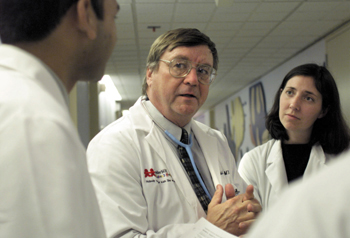
Dr. Arnold Strauss, chair of Pediatrics, believes that particular genes in children trigger heart disease. Strauss is one of the nation's leading authorities in pediatric cardiology research. (photo by Dana Johnson)
Radiation used to stop restenosis
Countless lives have been saved with balloon angioplasty, a procedure that is performed about a half million times each year in the United States.
But the procedure to open blocked coronary arteries is not fail-proof: a third or more patients return to the cath lab for repeat angioplasty or to the operating room for bypass surgery because the artery re-narrows (a process called restenosis).
In the 1990s, use of scaffold-like wire supports called stents to prop open the artery improved its success. Still, about 15 percent of patients still experience restenosis.
Now a new procedure, tested in clinical research at Vanderbilt Medical Center and other centers, is poised to improve success rates of angioplasty even more. The technique, which recently received approval by the U.S. Food and Drug Administration, uses low doses of radiation to prevent restenosis.
"Stents helped address this drawback of angioplasty, but there were still patients whose arteries became blocked again," said Dr. Robert N. Piana, associate director of Cardiology and director of cardiac catheterization for the Vanderbilt-Page Campbell Heart Institute.
"Several things have been tried, but this is the first to be proven effective at reducing the rate of restenosis."
Piana, who joined the Vanderbilt faculty in June, was an active investigator in trials of the new technique while in his previous position at Brigham and Women's Hospital in Boston. In 1998, Vanderbilt became the first center in Tennessee to use the new technique.
Angioplasty uses a special balloon that is guided on the tip of a catheter to the site of the blockage, then inflated to stretch the artery open and push the fatty plaque blocking the vessel against the artery wall. Stents are frequently used along with angioplasty.
While the non-surgical technique is effective at opening clogged arteries, the balloon's pressure can injure the artery wall. In some patients, the healing response becomes overzealous, leading to accumulated scar tissue inside the vessel.
The new procedure delivers, via catheterization, small amounts of radiation to the site of the lesion. The radiation is delivered for about five to 20 minutes depending on the type of device used.
Studies have shown that the procedure can reduce restenosis rates by about half.
"That radiation given is sufficient to prevent overproliferation or scarring caused by the cells," said Charles W. Coffey, Ph.D., professor of Radiation Oncology in the
Vanderbilt-Ingram Cancer Center. "This approach is known as the use of ionizing radiation to treat proliferative disorders. It is used in other areas, too, such in the removal of keloid scars or to treat a broken hip or elbow joint to prevent the bone cells from overgrowing across the joint and reducing mobility."
The technique requires close teamwork among the fields of cardiology, radiation oncology and medical physics.
Coffey, a medical physicist whose expertise is calculating and delivering the proper dose of radiation prescribed by a radiation oncologist, was a co-investigator in trials of the new technique at Vanderbilt, led by Dr. Robert Myers, associate professor of Medicine. Dr. Anthony J. Cmelak, assistant professor of Radiation Oncology, also was a co-investigator in the trial, which was part of the clinical research that led to the recent approval of one of two devices for delivering the radiation to angioplasty sites.
Plans call for providing the procedure to select patients within the next few weeks.
In the meantime, plans are under way for Vanderbilt-Page Campbell cardiologists to continue to pioneer new techniques to improve the success of angioplasty even further.
For instance, the new devices are FDA-approved only for use in patients who've undergone an angioplasty and experienced restenosis. The technique is intended to help improve success of the second angioplasty. But Piana said that future research may prove that the technique is useful for patients undergoing a first angioplasty.
Among the trials in which Vanderbilt-Page Campbell will participate is one that uses an angioplasty balloon that delivers the radiation dose at the same time the artery is being opened, rather than afterward. There are also studies under way to deliver the radiation doses to longer areas of blockage, which would make the technique applicable for a broader group of patients.
"Use of radiation to improve angioplasty success is an exciting new option for many of our patients," said Dr. Douglas E. Vaughan, C. Sidney Burwell Professor of Medicine and chair of the division of Cardiology. "The Vanderbilt-Page Campbell Heart Institute is committed not only to providing the latest techniques but also to be the leaders in developing new and improved ways to fight heart disease, the No. 1 killer in this country."
In addition to radiation, Piana said that cardiology will likely borrow on another well-known cancer approach to improve the effectiveness of angioplasty in the future. In the coming months, Vanderbilt expects also to test special stents coated with drugs intended to help prevent the cellular overgrowth in restenosis. One of these investigational stents is coated with paclitaxel, a widely used chemotherapy drug.













